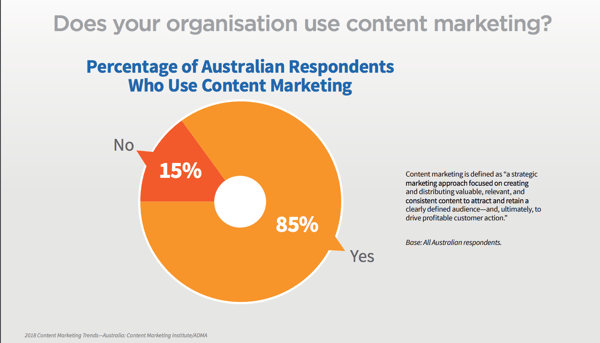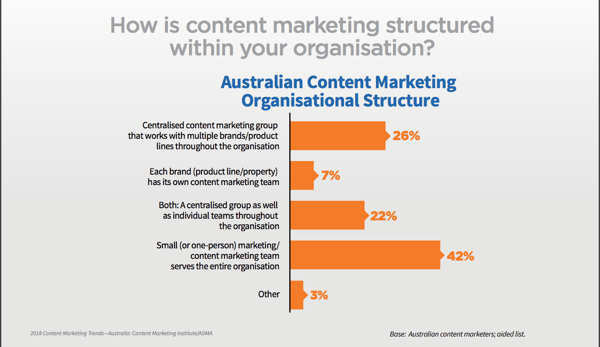Big companies with big budgets don't have to be the only ones using content marketing as a tactic anymore. Small business can join in too. It's no surprise that the popular tactic is very well-known to Australian businesses. A report by ADMA for this year showed some interesting results on the content marketing landscape in Australia.

We know that content marketing is important and we know that it's vital to stay ahead as the buyer's journey changes and moves online. However, our organisational structures do not support this narrative completely. So we try to find help outside the organisation to support content marketing initiatives and put some budget aside or a LOT of it.

Did you know?
Over nine in ten businesses in Australia are small businesses, accounting for 33 percent of GDP. They also employ 44 percent of the population!
Source: Australian Bureau of Statistics
If you are a small business and have to really consider how each dollar is spent to boost growth, there's more reason for you to consider ways to avoid using content marketing ineffectively. So if you're a small business, going full-steam ahead, here are some tips for you to ensure that your marketing budget is well spent:
1. Content with context is key
Website traffic with no conversions will not map back to ROI. It's important that you understand your buyer personas, create a sales and marketing funnel and a content strategy before you actually commission the writing job. Take stock of what is really important to your buyers and only work on creating word-y magic for them by being helpful and nice. You'll be surprised how much noise you can cull with a well-clarified SEO strategy using topic clusters. Email communication can also be more personalised and targeted if you have a well-thought out strategy for your buyer persona.
2. Create content consistently
Large volume isn't really important. You might be receiving numerous requests from marketing agencies who will propose writing 12 blogposts each month and drive a lot of website traffic.You don't have to buy in to that. All that we need to do be consistent is make a commitment and stick to it, even if you were writing only 4 blogposts a month. Make sure you pick a day and time that works and stick to it each week and month so your readers can form reading habits around the timing of your content and you will be creating an expectation that the next one will be coming up soon. Similarly with emails like monthly newsletters. No more wasted budget.
3. Connect content to a campaign
There's no point of randomly creating content whether that's 12 blogposts each month or just 3, they should essentially map to well-rounded campaign that has a great conversion path - landing page with a form and a thank you page with an email autoresponder. Your campaign goal must include the number of visits, no. of leads and the no. of customers you would like to get from all the myriad efforts. So one focus with multiple promotional means is key to make content marketing more effective.
Track results of your content marketing efforts and map it to ROI
There are many ways to figure out if all that we've done, to spend less and be more effective with content marketing, has actually worked. As HubSpot users, we use attribution reports that report on interaction and conversion on the website post reading a blogpost.
The content may have initially brought the website visitor to the page but they may leave without converting in that session itself. (Who knows their favourite TV show might've distracted them!) However, they might return to the website and submit a form when they have more time on their hands. Tracking or putting this together helps measure the effectiveness of your content marketing budget by mapping it to leads or sales.
Here's a list of metrics you can measure:
- Lead generation can be a strong metric as blogposts should have a call-to-action to push the reader to a landing page. Emails as well should have a conversion goal.
- Sales can also be measured to see if content marketing efforts resulting in revenue growth.
- Blog subscriptions can be effective at building loyalty and repeat purchases too.
- Your blog could also help introduce your brand to new and prospective clients so tracking new unique visitors might be useful.
- Social shares of blogposts enable you to expand your reach, as they get shared more that a website page.
To sum up, no more random content trying to capitalise on keywords. Search intent is more important to focus on - so think about the journey that your target buyer persona would potentially take, provide context to why your content is important to where they are at in the buying journey and ensure that a campaign conversion goal has been mapped to your content marketing.
Whether you have an in-house team or you look for help externally, this is more likely to increase ROI, reduce wasted budget and help you track results with ease.
Tags:
Marketing + Automation
March 8, 2018

